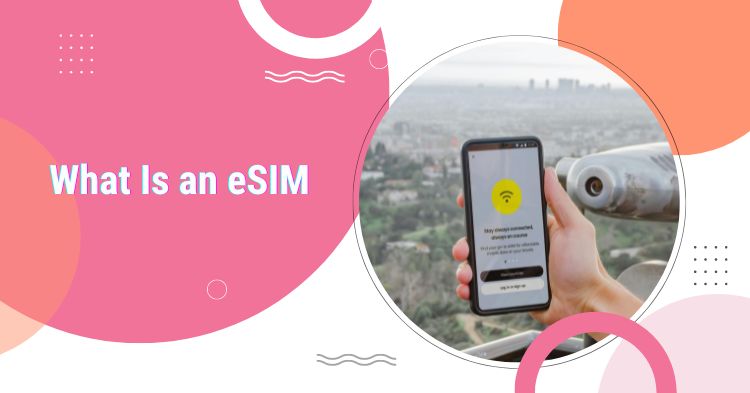In today’s fast-paced digital world, technology is constantly evolving, and our gadgets are getting smarter every day. One of the latest innovations in mobile technology is the eSIM.
With technological advancements like eSIMs, we can now enjoy greater convenience and flexibility when it comes to staying connected. But what exactly is an embedded SIM, and how does it work?
In this guide, we’ll explore everything you need to know about eSIMs, including the best providers in 2024.
What Is an eSIM?
An eSIM, or embedded SIM, is a small electronic chip embedded directly into your smartphone or device. Unlike traditional SIM cards that you insert into your phone, an embedded SIM is built-in and cannot be removed. This tiny chip holds all the information necessary to connect your device to a mobile network.
How Does an eSIM Work?
The magic of an embedded SIM lies in its ability to be reprogrammed. With a traditional SIM card, you need to physically swap cards if you want to change your phone number or network provider.
With it, you can switch providers and plans digitally, without needing a new physical card. It’s as easy as scanning a QR code or downloading a profile from your network provider.
Benefits of Using an eSIM
eSIMs come with a host of benefits that make them a popular choice for modern devices:
- Convenience: With an embedded SIM, you don’t have to worry about losing or damaging your SIM card. You can activate your phone or switch providers from the comfort of your home.
- Dual SIM Functionality: Many phones with embedded SIM capabilities also support dual SIM, allowing you to have two phone numbers on one device. This is great for people who want to keep work and personal numbers separate.
- Space Saving: They take up less space than traditional SIM slots, allowing manufacturers to use that space for other features, such as larger batteries or better cameras.
- Travel-Friendly: When traveling abroad, you can easily switch to a local network provider using an embedded SIM, avoiding expensive roaming charges.
How to Set Up an eSIM
Setting up an embedded SIM is usually straightforward. Here’s a step-by-step guide:
- Check Compatibility: Ensure your device supports this technology.
- Choose a Provider: Select a mobile network provider that offers eSIM services.
- Get an eSIM Activation Code: Your provider will give you a QR code or a manual activation code.
- Activate Your eSIM: On your device, go to the settings menu, find the mobile network section, and follow the prompts to scan the QR code or enter the activation code.
- Connect: Once activated, your device will connect to the network, and you’ll be ready to use your embedded SIM.
How to Choose a Reliable eSIM Provider
Choosing the right eSIM provider can make a big difference in your connectivity experience. Here are some tips to help you pick a reliable provider:
- Coverage: Check the network coverage offered by the provider in the areas where you live and travel. A good provider should have strong coverage locally and internationally.
- Plan Flexibility: Look for a provider that offers flexible plans that suit your needs. Whether you need a short-term data plan for traveling or a long-term plan for daily use, having options is crucial.
- Pricing: Compare pricing across different providers to find competitive rates. Look for any hidden fees and ensure the plan fits within your budget.
- Customer Support: Choose a provider with excellent customer support. In case you face any issues, responsive and helpful support can make a big difference.
- User Reviews: Read reviews and testimonials from other users to gauge the provider’s reputation. Positive reviews can indicate a reliable and trustworthy provider.
- Ease of Use: Ensure the provider offers an easy setup process with clear instructions. A user-friendly app for managing your embedded SIM can also be a plus.
Best eSIM Provider in 2024
With the growing popularity of eSIMs, many providers offer competitive plans. Holafly is a standout embedded SIM provider that offers a wide range of data plans, especially for travelers who want hassle-free internet access abroad. With its easy setup process and competitive pricing, Holafly is an excellent choice for anyone looking to stay connected without worrying about roaming fees.
Their focus on providing extensive coverage in numerous countries makes them an ideal option for globetrotters who want reliable internet access wherever they go.
When comparing Holafly vs. Airalo, Holafly stands out with its user-friendly interface and comprehensive support, which ensures that customers have a seamless experience from activation to usage.
Conclusion
eSIM technology is transforming the way we connect our devices to mobile networks. With its convenience, flexibility, and space-saving advantages, it’s no wonder eSIMs are becoming the standard for modern smartphones and other gadgets.
Whether you’re traveling the world or just looking for a more convenient way to manage your phone plan, an embedded SIM is a great choice.
FAQs
Q1. What Is the Difference Between an eSIM and a Traditional SIM Card?
A traditional SIM card is a physical card that you insert into your phone to connect to a mobile network. An eSIM, or embedded SIM, is built into your device and can be programmed remotely, allowing you to switch network providers without changing the physical card.
Q2. Can I Use an eSIM on Any Smartphone?
Not all smartphones support eSIM technology. Many modern devices, such as the iPhone XS and later models, Google Pixel 3 and newer, and Samsung Galaxy S20 series, support embedded SIM. Check your device specifications to confirm compatibility.




